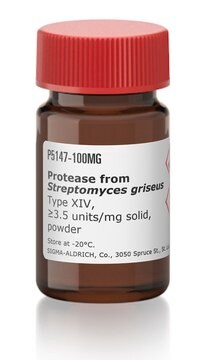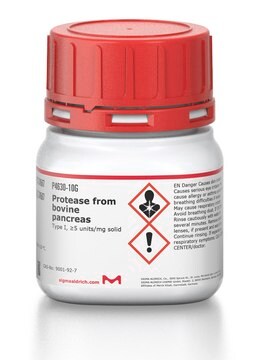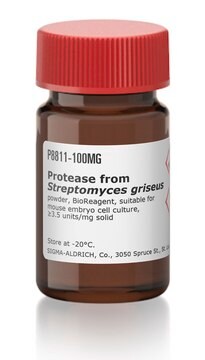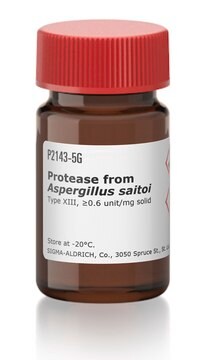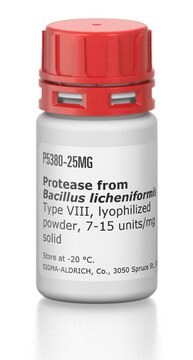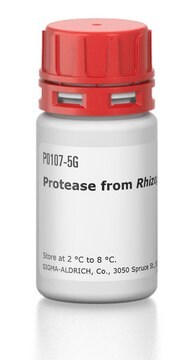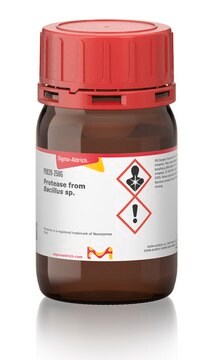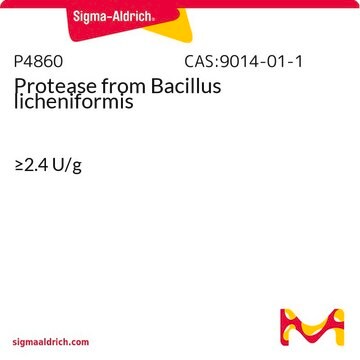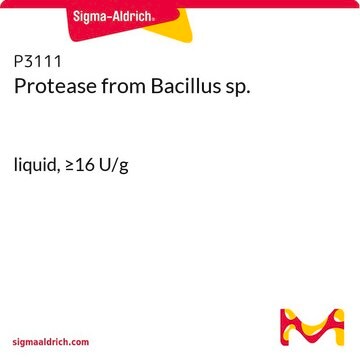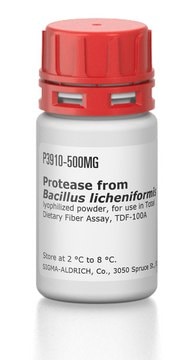P0652
Protease from Streptomyces sp.
Type XXI, ≥15 units/mg solid
Synonyme(s) :
actinase E, pronase E, Actinase E, Pronase E
Se connecterpour consulter vos tarifs contractuels et ceux de votre entreprise/organisme
About This Item
Numéro CAS:
Numéro CE :
Numéro MDL:
Code UNSPSC :
12352204
Nomenclature NACRES :
NA.54
Produits recommandés
Type
Type XXI
Niveau de qualité
Forme
powder
Activité spécifique
≥15 units/mg solid
Poids mol.
~50 kDa
Température de stockage
−20°C
Catégories apparentées
Application
Pronase E can be used to degrade antheraea pernyi silk fibroin films.
A mixture of at least three proteolytic activities including an extracellular serine protease. In general, serine proteases display a wide range of substrate specificities, which are believed to be mediated by an active site composed of one Asp, one His, and a Ser residue in the molecule. This enzyme prefers to hydrolyze peptide bonds on the carboxyl side of glutamic or aspartic acid.
Completely inactivated by heating above 80 °C for 15-20 minutes.
Protease is typically used in nucleic acid isolation procedures in incubations of 0.5-3.0 hours supplemented with 0.2% sodium dodecyl sulfate and 10 mM EDTA.
This enzyme is useful for proteolysis of insoluble protein and for structure investigation of protein. Proteases from Streptomyces griseus and Streptomyces omiyaensis have been used in a study to identify residue 71 as a crucial residue for differences in topological specificities. Proteases have also been used in a study to investigate production of protease as a by-product of streptomycin production.
Actions biochimiques/physiologiques
Alkaline protease that is approximately twice as active at pH 11.0 than at the usual assay conditions for protease, pH 7.5 and 37 °C. By comparison, P5147 Type XIV protease is only approximately 25% as active at pH 11.0, 30 °C.
Propriétés physiques
Isoelectric point : 8.7
Inhibitors : Diisopropyl fluorophosphate, EDTA
Optimum pH : >=12
Optimum temperature : 60oC
pH Stability : pH 5.0 - 11.5 (25oC,24hr)
Thermal stability : below 50oC (pH 8.3, 15min)
Inhibitors : Diisopropyl fluorophosphate, EDTA
Optimum pH : >=12
Optimum temperature : 60oC
pH Stability : pH 5.0 - 11.5 (25oC,24hr)
Thermal stability : below 50oC (pH 8.3, 15min)
Définition de l'unité
One unit will hydrolyze casein to produce peptide equivalent to 1.0 μmole (181 μg) of tyrosine per min at pH 11.0 at 30 °C.
Forme physique
This enzyme is more active at a higher pH range than the known alkaline protease, showing the proteolytic activity even in 0.2N NaOH solution. This enzyme is useful for proteolysis of insoluble protein and for structure investigation of protein.
Notes préparatoires
Collected from culture broth of S.Sp
Mention d'avertissement
Danger
Mentions de danger
Conseils de prudence
Classification des risques
Eye Irrit. 2 - Resp. Sens. 1 - Skin Irrit. 2 - STOT SE 3
Organes cibles
Respiratory system
Code de la classe de stockage
11 - Combustible Solids
Classe de danger pour l'eau (WGK)
WGK 2
Point d'éclair (°F)
Not applicable
Point d'éclair (°C)
Not applicable
Équipement de protection individuelle
Eyeshields, Gloves, type N95 (US)
Faites votre choix parmi les versions les plus récentes :
Déjà en possession de ce produit ?
Retrouvez la documentation relative aux produits que vous avez récemment achetés dans la Bibliothèque de documents.
Les clients ont également consulté
Paola Taddei et al.
Biomacromolecules, 7(1), 259-267 (2006-01-10)
In this study, Antheraea pernyi silk fibroin (Ap-SF) films were incubated with Protease Type XXI from Streptomyces griseus, at 37 degrees C, to investigate the degradation behavior in an in vitro model system. The enzyme-resistant fractions of Ap-SF films and
W W Epstein et al.
Proceedings of the National Academy of Sciences of the United States of America, 87(19), 7352-7354 (1990-10-01)
Prenylated proteins, labeled in the isoprenoid residue by growing CHO cells in medium containing [5-3H]mevalonate, were degraded by three different proteolytic procedures, enzymatic or alkaline hydrolysis as well as hydrazinolysis. The products thus obtained were analyzed by HPLC with chemically
Yoshiko Uesugi et al.
Biochimica et biophysica acta, 1814(10), 1295-1304 (2011-07-20)
We recently identified residue 71 of two homologous serine proteases from Streptomyces omiyaensis (SOT) and Streptomyces griseus (SGT) as a crucial residue for differences in their topological specificities, i.e. recognition of a distinct three-dimensional structure. To study the role of
A Proteolytic Enzyme of Streptomyces griseus: I. Purification of a Protease of Streptomyces griseus
Nomoto, M. and Y. Narahashi
Biochemistry, 46, 653-667 (1959)
The utility of nonspecific proteases in the characterization of glycoproteins by high-resolution time-of-flight mass spectrometry.
Juhasz, P. and Martin, S.A.
International Journal of Mass Spectrometry and Ion Processes, 169-170, 217-230 (1997)
Protocoles
Assay Procedure for Protease
Notre équipe de scientifiques dispose d'une expérience dans tous les secteurs de la recherche, notamment en sciences de la vie, science des matériaux, synthèse chimique, chromatographie, analyse et dans de nombreux autres domaines..
Contacter notre Service technique